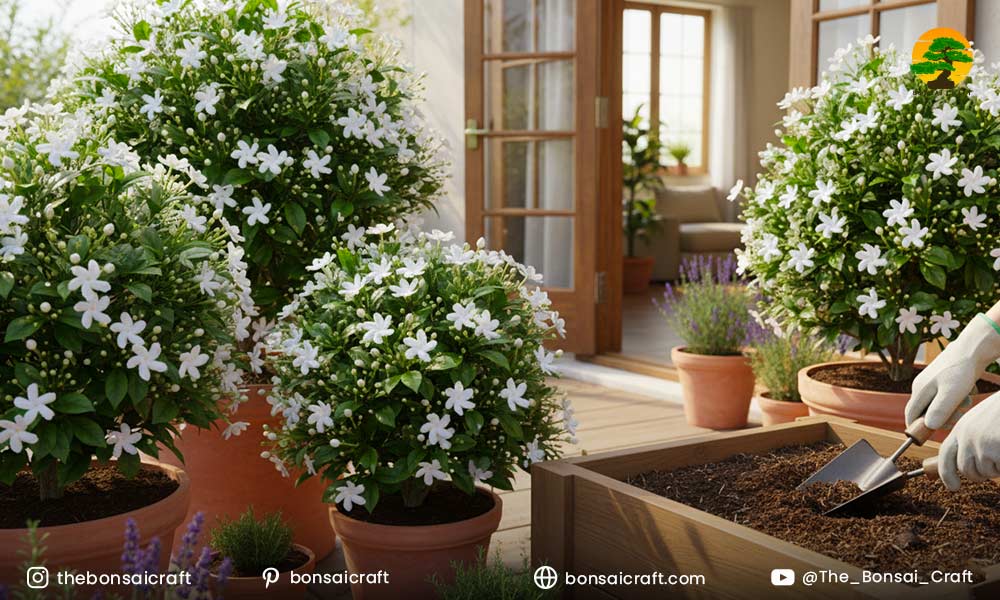
If you’re looking to fill your garden or balcony with one of the most fragrant and beautiful flowering plants, jasmine sambac is an ideal choice. Known as sampaguita, arabian jasmine, or pikake flower, this evergreen shrub has captivated gardeners for centuries across Asia and tropical regions. Not only does it provide a lush, aromatic display, but it also carries cultural, medicinal, and aesthetic value. With proper jasminum sambac care, you can enjoy its stunning white blooms almost year-round.
As a gardener with over a decade of hands-on experience growing flowering shrubs, I’ll guide you through everything—from choosing the right variety to watering, pruning, fertilizing, and encouraging blooms. This guide is rooted in both practical experience and verified horticultural research, ensuring you can grow a thriving jasminum sambac plant at home.
Understanding Jasminum Sambac
What is Jasminum Sambac?
Jasminum sambac is a fast-growing, evergreen vine or shrub native to South and Southeast Asia. It is highly valued for its fragrant white flowers that are used in perfumes, garlands, teas, and traditional medicine. In the Philippines, it is recognized as the national flower, called sampaguita, symbolizing purity and simplicity.
This plant belongs to the Oleaceae family and can grow up to 6–10 feet tall, depending on the variety. It thrives in warm climates (USDA zones 9–11) and requires sunlight, well-drained soil, and regular care to flourish.
Popular Jasminum Sambac Varieties
- J. sambac ‘Maid of Orleans’ – Rounded, single-petal flowers; easier to propagate.
- J. sambac ‘Belle of India’ – Produces both single and double blooms with long petals.
- J. sambac ‘Grand Duke of Tuscany’ – Double flowers resembling roses; slow-growing.
Tip: Choosing the right variety depends on your garden space and how much fragrance you want. Double-petal varieties usually produce a stronger aroma.
Jasminum Sambac Benefits
- Fragrance and Ornamentation – Its flowers release a sweet, fruity aroma that perfumes your garden.
- Cultural and Traditional Use – Widely used in garlands, religious ceremonies, and weddings.
- Medicinal Applications – Leaves and flowers are traditionally used for fevers, wounds, cough, and as a sedative or astringent.
- Environmental Contribution – Acts as a pollinator attractor, supporting bees and butterflies.

Choose the right spot for planting Jasminum sambac to ensure strong roots and abundant blossoms.
Choosing the Right Spot for Planting
Where to Plant Jasminum Sambac
Jasminum sambac grows best in full sun to partial shade. A location receiving 6–8 hours of sunlight daily ensures vibrant blooms. For container gardening, place pots on balconies, terraces, or near doors so the fragrance can be enjoyed indoors.
Soil Requirements:
- Well-drained, loamy soil with organic compost
- Slightly acidic to neutral pH (6.0–7.0)
- Avoid waterlogging to prevent root rot
Tip: Amend planting beds with compost or well-rotted manure before planting to boost growth and flowering.
Jasminum Sambac Care Guide
Watering
Keep the soil evenly moist but not soggy. Overwatering can cause root rot, while underwatering will limit flowering.
- Summer: Water 3–4 times per week depending on soil drainage
- Winter: Reduce watering, allowing the topsoil to dry between sessions
Container plants: Check soil moisture by sticking your finger 1–2 inches into the soil.
Light Requirements
- Full sun: 6–8 hours/day for maximum blooms
- Partial shade: Minimum 4 hours/day; blooms may be slightly reduced
Indoor tip: Place near a bright south-facing window or use a grow light during winter months.
Temperature and Humidity
- Ideal temperature: 65–85°F (18–29°C)
- Winter hardy in USDA zones 9–11
- Frost-sensitive; bring indoors if temperature drops below 55°F (13°C)
Fertilization Schedule
Feed your jasminum sambac plant monthly during the growing season with:
- Balanced fertilizer (N-P-K 10:10:10)
- Organic alternatives like compost tea or fish emulsion
Stop fertilizing in fall and resume in early spring to promote healthy growth.
Pruning Jasminum Sambac
Prune after flowering to maintain shape and encourage branching. Remove:
- Dead or diseased stems
- Overgrown vines that may shade inner growth
Pro Tip: Regular pruning improves air circulation, reducing the risk of leaf spot and pest infestations.
Propagating Jasminum Sambac
Propagation is best done via stem cuttings:
- Cut a 6-inch healthy stem just below a leaf node.
- Remove lower leaves to expose 2–3 inches of stem.
- Dip in rooting hormone and plant in moist, well-drained soil.
- Cover with a clear plastic bag to retain humidity.
- Roots appear in 4–6 weeks; new growth indicates successful propagation.
Tip: Keep cuttings in warm, indirect sunlight until fully established.
Growing Jasminum Sambac in Pots
- Choose pots with drainage holes
- Use a loamy, well-draining potting mix
- Provide a trellis or support for climbing varieties
- Repot every 2–3 years, slightly increasing pot size and refreshing soil
Indoor care: Ensure high humidity by misting leaves or placing pots near water trays.

Learn how to overwinter Jasminum sambac safely indoors to keep it thriving through colder months.
Overwintering Jasminum Sambac
- Mulch outdoor plants in zones 9–11 with straw, leaves, or compost to protect roots
- In zones 8 and below, bring potted plants indoors before night temperatures drop below 55°F (13°C)
- Reduce watering and stop fertilization during dormancy
Common Pests and Diseases
Pests:
- Aphids
- Spider mites
- Whiteflies
Prevention/Treatment: Spray neem oil or insecticidal soap; prune infested areas.
Diseases:
- Root rot (from overwatering)
- Leaf spot
Tip: Maintain well-drained soil and avoid wetting foliage during watering.
Encouraging More Blooms
- Provide adequate sunlight
- Water consistently but avoid soggy soil
- Fertilize monthly during growing season
- Prune to encourage branching and airflow
Fact: Post-harvest research shows flower storage at 4°C and 85% humidity preserves freshness and aroma.
Quick Care Summary Table
|
Care Aspect |
Requirement |
| Light | Full sun to partial shade (4–8 hrs/day) |
| Soil | Well-drained loamy soil, slightly acidic to neutral |
| Water | Keep soil moist, not soggy; reduce in winter |
| Fertilizer | Monthly during growing season (spring-summer) |
| Pruning | After flowering; remove dead stems and overgrown vines |
| Temperature | 65–85°F (18–29°C); frost-sensitive |
| Propagation | Stem cuttings; root in 4–6 weeks |

Find out how to harvest and use Jasminum sambac flowers for tea, fragrance, and beauty care.
How to Harvest and Use Jasminum Sambac Flowers
- Harvest fresh flowers early in the morning for peak fragrance
- Used in garlands, teas, and aromatherapy
- Flowers can be dried for potpourri or infused oils
Tip: Handle flowers gently to avoid bruising, which diminishes aroma.
Jasmine Sambac Benefits Recap
- Fragrant flowers – perfect for outdoor patios and indoor spaces
- Medicinal uses – leaves and flowers have sedative and astringent properties
- Pollinator-friendly – attracts bees and butterflies
- Cultural value – the national flower of the Philippines and used in rituals
FAQs (Schema-ready)
1. How do I care for Jasminum sambac at home?
To care for Jasminum sambac at home, provide full to partial sunlight, keep the soil evenly moist without overwatering, fertilize monthly during the growing season, and prune after flowering. Regular attention to sunlight, watering, and pruning ensures healthy growth, abundant blooms, and strong fragrance throughout the year.
2. Can Jasminum sambac grow in pots?
Yes, Jasminum sambac grows well in pots with good drainage and loamy soil. Use a container with drainage holes and provide a trellis for climbing varieties. Potted plants are ideal in cooler climates, as they can be brought indoors during frost, ensuring year-round survival and flowering.
3. How long does it take for Jasminum sambac to bloom?
Blooming typically begins in late spring and continues through early fall, depending on climate and variety. Tropical regions may see flowers multiple times a year. Proper sunlight, watering, and fertilization encourage faster and more prolific flowering, ensuring a fragrant display throughout the growing season.
4. What pests affect Jasminum sambac?
Common pests include aphids, spider mites, and whiteflies, which can damage leaves and flowers. Maintain good air circulation, prune regularly, and inspect plants often. Organic treatments like neem oil or insecticidal soap can control infestations while keeping the plant healthy and preventing disease.
5. What are the health benefits of Jasminum sambac?
Jasminum sambac flowers and leaves are used in traditional medicine for fevers, coughs, wound healing, and as a mild sedative or astringent. Additionally, the aromatic blooms reduce stress and improve mood. Regular harvesting and use in teas or essential oils allow you to enjoy both fragrance and therapeutic benefits.
